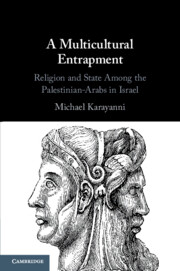Book contents
- A Multicultural Entrapment
- A Multicultural Entrapment
- Copyright page
- Dedication
- Contents
- Preface
- 1 Religion-and-State Conflict in Israel
- 2 The Janus-Faced Religion-and-State Conflict in Israel
- 3 Palestinian-Arab Religious Jurisdiction As an Individual Predicament
- 4 The Acute Nature of the Palestinian-Arab Individual Predicament
- 5 The Individual Predicament As Multicultural Entrapment
- 6 The Voice of No Exit
- Epilogue
- Bibliography
- Index
1 - Religion-and-State Conflict in Israel
The Absent but Present Palestinian-Arab Religious Minorities
Published online by Cambridge University Press: 08 January 2021
- A Multicultural Entrapment
- A Multicultural Entrapment
- Copyright page
- Dedication
- Contents
- Preface
- 1 Religion-and-State Conflict in Israel
- 2 The Janus-Faced Religion-and-State Conflict in Israel
- 3 Palestinian-Arab Religious Jurisdiction As an Individual Predicament
- 4 The Acute Nature of the Palestinian-Arab Individual Predicament
- 5 The Individual Predicament As Multicultural Entrapment
- 6 The Voice of No Exit
- Epilogue
- Bibliography
- Index
Summary
In many countries, minority religious issues figure centrally in the religion-and-state debate. Western legal systems have long grappled with the way they should accommodate religious minorities, such as the Mormons (polygamy), the Amish (home schooling), Muslims (the veil, shari’a tribunals, halal slaughter of animals), the Jewish community (yarmulke in the military, male circumcision) just to name a few. Yet, in Israel the debate excludes the different religious minorities and is Jewish majority-centered. This chapter exposes the exclusive nature of the religion-and-state debate while showing the rather rich and diverse religion-and-state conflicts produced by the Palestinian-Arab religious minorities since the establishment of the state of Israel until the present day. These conflicts include challenges to Israel’s criminalization of polygamy, the creation of a civil cause of action in order to challenge such religiously sanctioned practices as unilateral divorce, overt discrimination in budgetary allocations for the Palestinian-Arab religious communities, the extraterritorial jurisdictional authority of Palestinian-Arab religious tribunals, and much more. This suggests that the Jewish-centered nature of the religion-and-state debate in Israel is a matter of constitutional design, and this is in fact what I will argue all throughout.
- Type
- Chapter
- Information
- A Multicultural EntrapmentReligion and State Among the Palestinian-Arabs in Israel, pp. 1 - 41Publisher: Cambridge University PressPrint publication year: 2020

